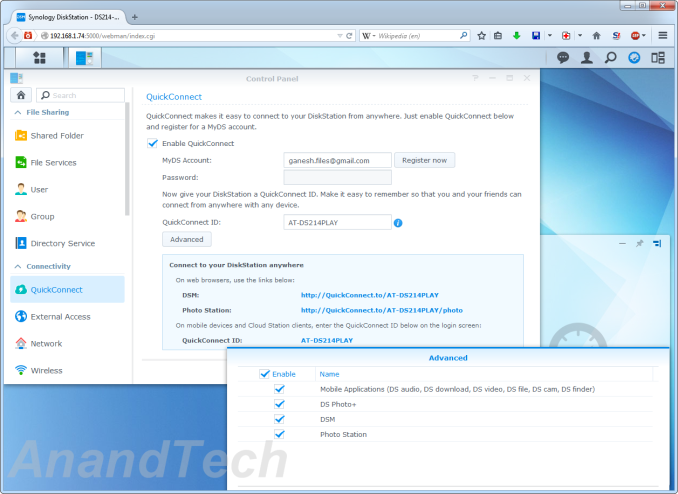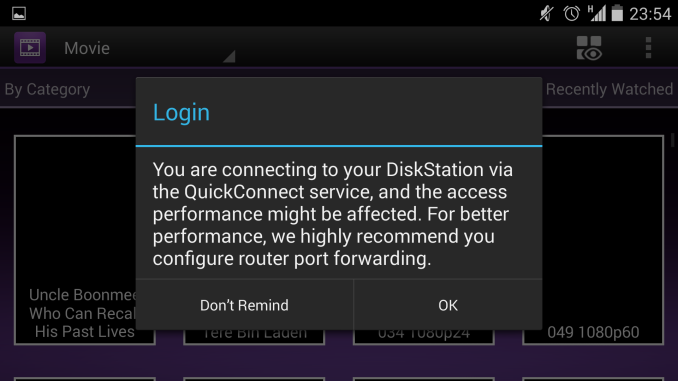Synology DS214play: Intel Evansport Almost Done Right
by Ganesh T S on May 20, 2014 3:00 PM ESTDSM 5.0: External Access
As mentioned in an earlier section, going through all the features of DSM 5.0 in detail would be beyond the scope of this review. However, the DS214play's claim to fame is its multimedia capabilities. It is only fair that we have a few sections devoted to the multimedia and external access (for multimedia streaming) features of the firmware. First, we take a look at the external access features of DSM 5.0.
A Synology NAS can be accessed from an external network through two different methods. In the first case (for users who don't want to be bothered with port forwarding on their routers), the connection is made through Synology's relay servers. Each NAS intended to be accessed in this way has to be provided with a unique QuickConnect ID (that is registered with Synology). Synology allows registration only with a valid MyDS account.
The QuickConnect settings can be found in the DSM interface under the Control Panel's Connectivity options. External access can be regulated on a per-service basis (in terms of access to just the mobile apps for multimedia streaming, or even NAS management using the DSM UI itself). Accessing a NAS from an external network through Synology's relay servers results in helpful cautionary messages about possible slowness (when using bandwidth-intensive apps such as DS Video).
Port forwarding settings can be accessed via the 'External Access' section right after the 'QuickConnect' settings in the Control Panel. Synology supports multiple DDNS services and also offers their own. Users who have configured QuickConnect already have a QuickConnect.to DDNS setup and don't need to add another. In order to configure port forwarding, the DSM mandates that the unit must be set to receive a static IP (i.e, DHCP disabled). In case the router supports UPnP, the DSM can automatically create the port forwarding rules and apply it. The sequence of steps is shown in the gallery below.
Home users often have data on their NAS that they might want to share with friends in a quick and easy manner. DSM makes this task very easy, provided QuickConnect (or some other DDNS) is already set up. The gallery below outlines the steps in generating a shareable link for any file on the NAS.
The link can be used to download the file without entering login credentials (that are otherwise necessary when accessing the NAS using QuickConnect) and the validity period can also be customized. The link can also be protected with a password. The only minor point of complaint here is the fact that the generated link has the local IP address in it. Usually, the links are shared with people outside the local network. It would be nice if the hardcoded IP were to be replaced with a link based on the QuickConnect ID (if one exists). Full folders can also be shared through this method. In that case, the web browser presents a File Station interface in the browser. For one or two files, using the relay servers works OK. However, when sharing full folders, it might be a better option to forward port 5000 in the router to the Synology NAS.
























45 Comments
View All Comments
Chloiber - Tuesday, May 20, 2014 - link
Exactly.I don't own a NAS yet, but plan to buy a Synology 4b NAS (probably DS414). I'm a very tech savvy person and have built my own PCs since years - but I just want a NAS that works, that I have to setup once in a matter of minutes and never (or rarely) worry again. I don't want to waste any more free time on these things
awktane - Tuesday, May 20, 2014 - link
I have a much larger version. Reasons I chose a NAS device rather than building my own:-8 disks in pretty much the same space as it would take to store 8 hdds side by side on their own
-My time is worth more than the cost difference. I can turn features on with a click rather than installing and configuring packages.
-In the event of a failure I don't want to have to set it all up again. I don't want to cause a failure accidentally or some update to screw things up. I can't afford downtime.
-Fewer possible points of failure. The hardware is much simpler and streamlined.
cjs150 - Tuesday, May 20, 2014 - link
I have had a NAS for 2-3 years. (QNAP).I would never bother with a 2 bay NAS, I want redundancy, as HDs do fail. I know that technically ZFS is a better solution than RAID 5 but for a home media store, RAID 5/6 is fine.
Yes I could build a cheap Mini-ITX build to do the same job, but a good NAS takes 5 mins to set up (then about 10 hours to build a 6TB RAID 5 array!) and should simply work.
Perfect for people like me who do not have the time to spend fiddling with it for optimum set up and have a family wanting access to the film library now!
Beany2013 - Tuesday, May 20, 2014 - link
I think when my DS214+ needs replacing (or when I find £500 down the back of the couch, etc) one of the chunkier, VMware/citrix/HyperV certified units will be next - I can then justify building another VM server and using that as a small SAN type thingy.I can use the DS214 as an iSCSI host, but it's not really quick enough over a single GbE link, and I don't have trunking/aggregating capable switch to boost performance...
In time...oh yes, in time....
bznotins - Tuesday, May 20, 2014 - link
Thanks for the discussion, it's really helped me to understand the benefit of a unit like this (mostly time/simplicity). Which are perfectly good reasons to go that route.What I was concerned about was that I was missing some other benefit of a NAS other than time/ease. It doesn't appear to be the case.
As someone who needs four drives + optical (ripping) + SSD (OS), I have always just leaned toward rolling my own. I love the ability to use TeamViewer to remote into my PC and manage things. Plex runs great. I keep AirSync native on it to sync my music collection to my Android devices over WiFi. In order to manage my media, it's great to be able to run Media Companion on it.
I guess for all my needs, if I got one of these NAS boxes I would still need a full-time PC to manage my media and streaming needs. Thus, it makes sense to take the time and effort to build my own.
Appreciate the discussion.
Major_Kusanagi - Tuesday, May 20, 2014 - link
I got an incredible deal on a Dell T20 Server: $199 with a Haswell processor and 4GB of RAM to start. The expansion abilities are nice, to include up to 6 drives (13TB total space). Granted, I could have built my own, but getting an actual server with a modern processor for $199 can't be beat.GTaudiophile - Tuesday, May 20, 2014 - link
I must be the idiot then. About 3 years ago I build a small tower using a AMD Athlon X2 quad-core CPU, 16GB ECC RAM, and 4x 1TB drives running FreeNAS7 in a ZFS2 configuration. Performance through SAMBA was simply abysmal. Earlier this year I bought the DS214play and it just works the way I want it to. I run 2x 4TB drives in RAID1 using the old 4x 1TB drives as a backup to the NAS. I love that it's a small, silent box that sits on an IKEA Expedit shelf. it hides behind a photograph. Performance through SAMBA is much better than what I experienced before. Setup and Web access is indeed idiot proof. And most of all I feel I have great support (and apps) behind the product. I frankly got tired of doing the "nerd" solution. I just wanted something small, silent, supported, and highly functional. The DS214play does this for me.Major_Kusanagi - Tuesday, May 20, 2014 - link
I don't think you're an idiot GTaudiophile, sometimes I don't want to deal with the whole 'geek out' thing either, and I'm a Systems Administrator. :-pbsd228 - Tuesday, May 20, 2014 - link
Poor samba performance 3 years ago points to problems around the SMB1->2 migration, particularly when we're talking about freenas7. MS made it a moving target. Eventually solved. But you're cheating a bit by comparing it to 3 years later technology. If you have rebuilt with a more recent freenas release, or gone to solaris, you'd have also seen better samba performance.chaos215bar2 - Tuesday, May 20, 2014 - link
I know this is somewhat tangential to the main review, but since you mention Photo Station, one important thing to note is that it does not properly support photos in non-sRGB color spaces (including AdobeRGB which is very common in mid-to-high end cameras). These photos all end up looking muddy and washed out in Photo Station, since the color space is discarded during processing.